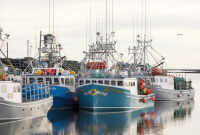Support strong Canadian climate journalism for 2025
The federal government and the province of B.C. on Friday announced 23 projects will receive about $13 million in funding for salmon restoration this year.
Projects vary from stream stabilization to infrastructure updates to updating hatcheries.
Ottawa and the B.C. government are investing in the province’s Salmon Restoration and Innovation Fund for the next five years. Canada committed $100 million over five years, while B.C. committed $42.85 million over the same period.
The projects are meant to help strengthen B.C.’s salmon, which face issues such as habitat degradation and low populations.
Skeetchestn Indian Band is one of the funding recipients. Skeetchestn is working on land restoration with eight other communities from the Secwepemc Nation, in a collective called the Secwepemc’ulecw Restoration and Stewardship Society.
The society, along with a sustainable-forestry project called Forest Foods, will use the money to stabilize the salmon spawning beds of Bonaparte River in Secwepemc’ulecw (Secwepemc territory).
“This is just one component of an overall vision we have to rebuild the biodiverse forests throughout the Shuswap Nation,” Kukpi7 Ronald Ignace, the band's chief, said. “We’re looking down the road to climate change and hoping to contribute to the remediation of climate change as much as we can.”
Skeetchestn and Forest Foods have done similar restoration work at Deadman River in Skeetchestn territory.
Shelby Leslie, owner of Forest Foods, said plans include training Indigenous land guardians, doing satellite and on-the-ground surveying and assessing how to restore riparian habitats — the spaces where rivers meet streams.
“One of the interesting things is the Secwepemc’ulecw Restoration and Stewardship Society will be engaging private landowners that actually hold a lot of the land around some of the most damaged riparian zones,” he said.
The partners plan to write contracts with these landowners allowing them to do restoration work on private land.
Ignace said working jointly with Secwepemc nations and all levels of government is essential to fighting climate change.
“We’re trying to work with multi-stakeholders, because we’re all in this together,” he said.
The Cowichan Valley Regional District, in partnership with Cowichan Tribes, also received funding. They are doing a feasibility study to rebuild the Cowichan Lake Weir, which controls outflow from the lake into Cowichan River.
"Warmer waters and rivers can be lethal to not only the salmon populations but resident trout," district chairman Ian Morrison said. "We're looking at trying to perhaps build a new weir that will have cold-water infusion into the flows, which will make it a more sustainable, more healthy environment for fish."

Jonathan Wilkinson, federal fisheries, oceans and the Canadian Coast Guard minister, made the announcement in Vancouver alongside Lana Popham, B.C.’s agriculture minister.
Wilkinson said these projects contribute to restoring budget cuts and lost protections for fish habitats under prime minister Stephen Harper.
“After years of cutbacks and underfunding under the Harper government, and the previous government also rolling back protections for thousands of our waterways and at-risk species, we are delivering on our commitments that we made to restore and modernize those lost protections to rebuild our wild fish stocks,” he said.
Wilkinson said 70 per cent of the projects receiving funding are led by or include Indigenous communities.
Fisheries and Oceans Canada has taken several measures to protect salmon, including setting controversial restrictions on fishing Chinook salmon that sparked criticism from Indigenous communities and recreational fisheries.
The department launched an Indigenous Habitat Participation Program on June 7 with $50 million to engage Indigenous Peoples in fish conservation.
Hours after announcing the salmon restoration fund on Friday, Wilkinson was on Katzie territory in Pitt Meadows, B.C., where he announced the government had signed an agreement with 76 First Nations to collaborate on fisheries issues in the Fraser River.
Wilkinson said measures to restore salmon and marine life are closely related to other environmental legislation by the federal government, including establishing the $1-billion Canada Nature Fund and plans to ban single-use plastics by 2021. Ocean plastics harm marine life and some emit greenhouse gases.
"If we don't succeed on all of these fronts, then we will fail on all of these fronts," he said.
"The work that we are doing to address habitat is one piece of a broader puzzle, where my colleague, (Environment and Climate Change Minister) Catherine McKenna, is leading the work on addressing climate change."






Comments